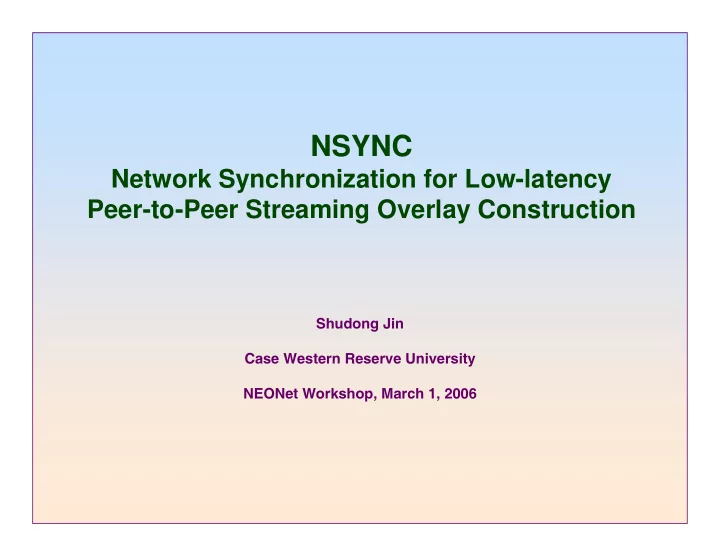

NSYNC Network Synchronization for Low-latency Peer-to-Peer Streaming Overlay Construction Shudong Jin Case Western Reserve University NEONet Workshop, March 1, 2006
Peer-to-Peer Streaming � Peer-to-peer systems versus client/server systems � Eliminate the performance bottleneck problem � Eliminate the single point-of-failures � Media streaming: a media stream is played while being received. � Video-on-demand (stored media such as movies) � Conference broadcast, live shows, sports events � Interactive games, real-time conferencing � How to construct an overlay network for peer-to-peer streaming? � High-quality media streams � Low peer-perceived latency -2-
Problem One: Long Latency � Peers need to buffer a portion of the media stream � Peer B receives media data from peer A. � A long latency may be found unnecessary later � If this latency is not trimmed, the average latency of the system could be unbounded (early peers leave and new peers join) � Find peers with low-latency as parent, but … -3-
Problem Two: Inefficient Overlay � There is a strict partial ordering of the peers � It doesn’t make sense for an earlier peer to receive media data from a later peer � This partial ordering limits the space for overlay network construction (and potentially results in low quality) S short delay long delays A B -4-
NSYNC Objectives � NSYNC: Network Synchronization for peer-to-peer streaming overlay construction � NSYNC is � A set of primitives to help construct and optimize streaming overlay � A method that can be used in other peer-to-peer streaming systems � NSYNC is not � A peer-to-peer system with its own overlay network construction -5-
NSYNC Ideas � The principles � To capitalize on the flexibilities of streaming applications � To exploit temporal locality and geographical proximity � Flexibilities of streaming applications � Increase/decrease the speed of playing a media stream � Temporal and geographical � Peers that are geographically close to each other can be temporally close too. � If not, we can make that happen! -6-
NSYNC Assumptions -7-
NSYNC Primitives � Provided primitives? � increase the speed of playing a media ((1+ ∆ ) times the normal rate) � decrease the speed of playing a media � increase the speed of receiving a media � decrease the speed of receiving a media? � Combined in use with other operations � switch to another peer as a parent � reverse client/server roles -8-
NSYNC for Peer Catching � Scenarios � Peer B receives a media stream from peer A. Peer B finds the lag behind A is unnecessarily large. For example, � The path is less congested, and has few delay jitters � A’s other three children left � Peer B’s previous parent left and B locates A as the new parent who is well ahead of B. � Let us use NSYNC to construct a catching process -9-
Catching Process With normal receiving rate With (1+ ∆ ) times normal receiving rate -10-
NSYNC for Peer Reversal � Scenarios: � Initially peer B receives a media stream from A, who receives the media stream from S. They find it is better for B to receive it from S and relay it to A. � Let us use NSYNC to construct a reversal process for A and B -11-
Reversal Process What if A didn’t buffer a large enough portion of the media stream? Its buffer could be drained during the switching. Solution: A plays more slowly before the reversal process. -12-
Open Questions: Implementation � What primitives should be provided in NSYNC? � What meaningful operations (and processes) can be constructed using the primitives? � Who, when, and how to decide what processes should be started to improve the performance and optimize the network? -13-
Open Questions: Algorithms � Graph algorithms and scheduling? Examples: � In a directed acyclic graph where T(child)<T(parent), how can we schedule a sequence of caching processes to minimize the latency as quick as possible? Maybe easy. � How can we schedule a sequence of reversal processes to minimize the average latency of all peers? Assume one peer can be involved in one reversal process at one time. Could be very difficult. � Even simple problems become difficult, considering the decentralized nature of the networks. -14-
Open Questions: Deployment � Which peer-to-peer systems really like to have NSYNC? Likely it depends on the type of streaming applications � Are there any technical barriers for the deployment of NSYNC? For example, some media players may not support a ∆ increase of the playing speed. � Are there any non-technical barriers? -15-
Recommend
More recommend